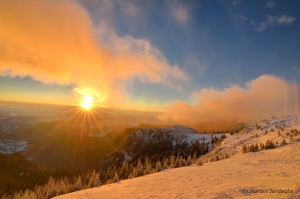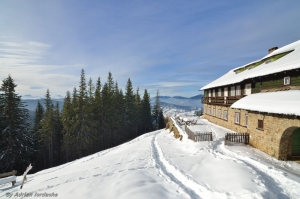“Man can master nature as long as he respects its laws” – Grigore Antipa
Ceahlau National Park
Ceahlau Mountain is the most renowned and impressive massif situated in the central part of the Eastern Carpathians, being one of the few Carpathian formations that retains unaltered samples of nature to this day. Moreover, Ceahlau is highly abundant in mythology and legends. Here you are able to meet Baba Dochia, Vulturul lui Traian, Panaghia, Toaca and many more.Surrounded by Bistricioarei valley in the north, Bicaz valley in the south, Bistritei valley in the east and Bistrei, Pinticului and Jidanului valleys in the west, Ceahlau comprises a system of circularly arranged peaks, with altitudes varying between 1000 and 1300 metres, and which converge to the two highest points: Ocolasul Mare Peak – 1907 metres and Toaca Peak – 1904 metres.
In this temperate continental climate, depending on the altitude variation of the natural habitats, we are able to lay our eyes upon many differed species of orchid, including Nigritella rubra, the Red Orchid, and Nigritella nigra, the Black Orchid, as well as Lady’s Slipper (Cypripedium calceolus), Globeflower (Trollius europaeus), White dryads (Dryas octopetala) or Edelweiss (Leontopodium alpinum), all being species of flora protected at a European level.
Along the numerous mountain paths, fauna specific to mountainous areas may also be seen, ranging from diversely coloured frogs (Bombina variegate – the yellow bellied toad) and newts (Lissotriton montandoni – the Carpathian newt), to lizards (Zootoca vivipara – the viviparous lizards) and adders (Vipera berus – the Common European adder), and even a plethora of birds (Great Tits, Coal Tits, Willow Tits, European Crested Tits, Wood Nuthatches, Buzzards, Owls) and mammals (Deer, Stags, Bears, Wolves and even Lynx).
“Nature realities surpass our most ambitious dreams” – François-Auguste-René Rodin, sculptor









